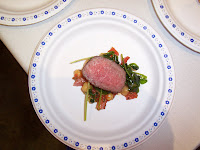 The event was a tasting at our local liquor store. And yes, it was the press release announcing Wolf Blass would be rolling out their 2004 Bilyara Reserve Cabernet Sauvignon and 2005 Bilyara Reserve Chardonnay in “environmentally friendly PET containers” that attracted my attention. Actually, it attracted my ire. Drink wine from the same, ugly container I pour my OJ out of? No way. I want beauty with my wine.
The event was a tasting at our local liquor store. And yes, it was the press release announcing Wolf Blass would be rolling out their 2004 Bilyara Reserve Cabernet Sauvignon and 2005 Bilyara Reserve Chardonnay in “environmentally friendly PET containers” that attracted my attention. Actually, it attracted my ire. Drink wine from the same, ugly container I pour my OJ out of? No way. I want beauty with my wine.I arrived at the tasting gunning for bear – or more accurately, gunning for Wolf. The fragrance of roast lamb from behind the demonstration kitchen appeased me momentarily – the folks at LCB usually like to further entice people with food. I still couldn’t see those ugly wine containers, but there were a couple of bottles sporting the distinctive Wolf Blass label sitting on a display table with a particularly charming young man apparently eager to pour for me standing behind. Twist my arm.
I reach for the Chardonnay just as a voice behind me says: “Think you could get away with this with a regular wine bottle?” I turn just in time to see a woman grab a wine bottle from the Wolf Blass display, and with great aplomb, hurl it to the floor. I’m not sure if my eyes went as wide as the young couple’s who were standing in front of her did.
But the anticipated sound of shattering glass never happened. The young man behind the table was suppressing a laugh. I picked up the bottle he’d just poured from – plastic. I’d been had.
And the wines? The Chardonnay was surprisingly pleasant – a bit too much oak for my taste, but not the overpowering wood bomb I’d anticipated. And it went superbly with
 the halibut appie created by Kristopher Barnholden, executive chef at the Stanley Park Pavilion (shown above with his assistant Chris and Susan in between). The Cab was overall disappointing – lacking in body but not bad as an afternoon sipper for when you want a patio red. And it did complement the lamb shown here that was our second tasty treat from Chef Kris.
the halibut appie created by Kristopher Barnholden, executive chef at the Stanley Park Pavilion (shown above with his assistant Chris and Susan in between). The Cab was overall disappointing – lacking in body but not bad as an afternoon sipper for when you want a patio red. And it did complement the lamb shown here that was our second tasty treat from Chef Kris. After a lengthy discussion with my jovial, gentleman pourer, we agreed it was probably grossly unfair to either wine to attempt making a true assessment out of the mini plastic (what else?), disposable wine glasses used at these events. He stressed the concept that a plastic bottle would allow you to chill the wine faster while carefully sidestepping my question that surely the reverse would also hold true – they would also come back to room temperature faster. And although I could never quite get him to say he actually liked plastic bottles, we did have a meeting of minds that this alternative might be great for picnics or hiking due to its much lighter weight.
Bonus, these bottles also save you about a dollar per bottle over the same wine in glass. But wine from a plastic bottle? This is going to take me a while.
Note: When I asked Frank for his thoughts on vintage PET bottles, there was an uncharacteristic silence that stretched out for a long moment. “Well, what do you think?” I asked again. He mumbled something that sounded remarkably like “too weird – not even going to comment on that one” and just walked away. Guess we’ll still be hauling glass for our summer picnics – which is quite okay with me.
More info of interest:
The lightweight PET bottle holds the same amount of wine as a standard 750ml wine bottle, yet it is designed to be 33 percent shorter for easier storage in a refrigerator, cooler or cupboard. It is fully recyclable and weighs just 54 grams prior to filling, offering an immediate 85 percent reduction in packaging weight. With the reduction in weight, more wine can be transported per load than with glass bottles, so the net environmental benefit from the reduction of fuels used in shipping and trucking is significant.
FYI: Here’s the Wicipedia definition of PET bottles.
Polyethylene terephthalate (aka PET) is a thermoplastic polymer resin of the polyester family that is produced by the chemical industry and is used in synthetic fibers; beverage, food and other liquid containers; thermoforming applications; and engineering resins often in combination with glass fiber.

No comments:
Post a Comment